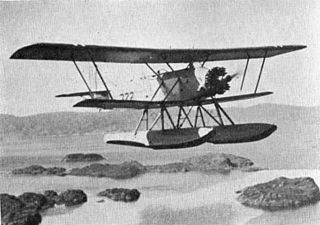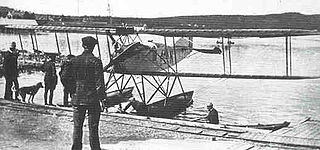Related Research Articles

The Heinkel He 115 was a three-seat World War II Luftwaffe seaplane. It was used as a torpedo bomber and performed general seaplane duties, such as reconnaissance and minelaying. The aircraft was powered by two 960 PS BMW 132K nine-cylinder air-cooled radial engines. Some later models could seat four, had different engines or used different weapon arrangements.

Oskar Omdal was a lieutenant and pilot in the Royal Norwegian Navy.

HNoMS Kjell was the final ship of twenty-seven 2nd class torpedo boats built for the Royal Norwegian Navy, launched at the Royal Norwegian Navy's shipyard in Horten on 12 March 1912 with build number 106. Kjell saw more than 32 years of service, the first 28 years in the Royal Norwegian Navy during the First World War and in the interwar period, the last four in the Kriegsmarine, having been captured in the first days of the 1940 Norwegian Campaign. After being rebuilt as a minesweeper by the Germans, she was sunk by Royal Air Force de Havilland Mosquito fighter bombers on 28 September 1944. Divers rediscovered the shipwreck in 2006.

The Marinens Flyvebaatfabrikk M.F.11 was a three-seat, single-engined biplane used by the Royal Norwegian Navy Air Service for maritime reconnaissance in the decade before the Second World War.

The Marinens Flyvebaatfabrikk M.F.12 was a seaplane built in Norway in 1939 as a military trainer aircraft to replace the Norwegian Navy's aging fleet of M.F.8 trainers. Only a single prototype was constructed before Germany's invasion of Norway in 1940. The prototype, M.F.12 F.14 (V), was the last trainer built for the Royal Norwegian Navy Air Service (RNNAS).

The Marinens Flyvebaatfabrikk MF.8 was a military training seaplane built in Norway in the 1920s.

The Marinens Flyvebaatfabrikk M.F.9 Høverjager, also known as the Høver M.F.9 after its designer, was a fighter seaplane built in Norway in the 1920s.The Illustrated Encyclopedia of Aircraft. London: Aerospace Publishing. p. 2144.

The Marinens Flyvebaatfabrikk M.F.10 was a military trainer seaplane built in Norway in 1929.

The Marinens Flyvebaatfabrikk M.F.1 was a two-seat biplane floatplane, the first aircraft produced by the Royal Norwegian Navy Air Service's aircraft factory Marinens Flyvebaatfabrikk in Horten, built after Maurice Farman's MF.7 design. The construction began in the summer of 1915, with plans borrowed from the Norwegian Army Air Service's aircraft factory at Kjeller.
The Marinens Flyvebaatfabrikk M.F.2 was a two-seat military biplane floatplane produced by Marinens Flyvebaatfabrikk in 1915 and 1916. It was designed by naval captain Halfdan Gyth Dehli, based on former models by French designer Maurice Farman and improvements by Einar Sem-Jacobsen of the Norwegian Army Air Service's aircraft factory Kjeller Flyfabrikk.
The Marinens Flyvebaatfabrikk M.F.3 was a reconnaissance floatplane built by the Royal Norwegian Navy Air Service aircraft factory Marinens Flyvebaatfabrikk in 1917. The aircraft was financed by extraordinary appropriations during the First World War and served until October 1924.
Kristian August Østby was a Norwegian naval aviator.
The Marinens Flyvebaatfabrikk M.F.5 was a two-seat biplane floatplane built by the Royal Norwegian Navy Air Service aircraft factory Marinens Flyvebaatfabrikk from 1918. The M.F.5 was the first tractor configuration aircraft designed and built in Norway. During almost eight years of service the M.F.5 was mainly used as a reconnaissance aircraft, although one example saw service as a trainer.
The Marinens Flyvebaatfabrikk M.F.7 was a two-seat biplane floatplane built by the Royal Norwegian Navy Air Service aircraft factory Marinens Flyvebaatfabrikk in 1923. The M.F.7 was designed and employed as a trainer aircraft, and functioned as a temporary solution until a better aircraft was designed. Soon after it entered service, the aircraft factory's experience with the M.F.7 led to the construction of the Marinens Flyvebaatfabrikk M.F.8, which remained in service as the main trainer aircraft of the Royal Norwegian Navy Air Service until the German invasion of Norway in 1940.
The Marinens Flyvebaatfabrikk M.F.6 was a two-seat biplane floatplane built by the Royal Norwegian Navy Air Service aircraft factory Marinens Flyvebaatfabrikk in 1921. The M.F.6 was designed and employed as a trainer aircraft. The type was the last pusher configuration aircraft in service with the Royal Norwegian Navy Air Service. The M.F.6 functioned as a makeshift solution until a more modern tractor configuration aircraft could be built. The type was retired once a more permanent solution to the Royal Norwegian Navy Air Service's training needs was found in mid-1920s.

Tromsø Airport, Skattøra, also known by its military designation Skattøra Naval Air Station was a water aerodrome and air base situated at Skattøra in the city of Tromsø in Tromsø Municipality in Troms county, Norway. Construction began in 1938 and the aerodrome was in use until 1975. At its peak it was the largest water airport in Northern Europe.

Ålesund Airport, Sørneset was a water aerodrome and later heliport situated at Nørvevika and later Sørneset in Ålesund, Norway. The airport was, to a varying degree, used between 1929 and 1979. It has since been demolished.

Kristiansand Naval Air Station was a water military air base operated by the Royal Norwegian Navy Air Service between 1919 and 1940. Situated at Tangen in the city center of Kristiansand, Norway, it consisted of three hangars. The station was to house both reconnaissance and fighter aircraft.

Kristiansand Airport, Kongsgårdbukta was a water airport serving Kristiansand, Norway, from 1934 to 1939. Situated at Kongsgårdbukta, it consisted of a floating dock and a small terminal building. Widerøe served the airport the first year, thereafter flights were carried out by Norwegian Air Lines. The airport was closed for the opening of Kristiansand Airport, Kjevik.
References
- 1 2 Arheim 1994, p. 9
- 1 2 3 Frebergsvik, Lars. "Flyfabrikken fra sped start i 1912 til nedleggelse i 1965". Borreminne (in Norwegian). Borre Historielag. Archived from the original on 11 August 2007. Retrieved 9 October 2011.
- ↑ Hafsten and Arheim 2003, p. 208, 213
- 1 2 3 4 Hafsten and Arheim 2003, pp. 213–214
- ↑ Arheim 1994, p. 13
- ↑ Hafsten and Arheim 2003, p. 213
- ↑ Hafsten and Arheim 2003, p. 99
- ↑ Arheim 1994, p. 12
- ↑ Hafsten and Arheim 2003, p. 65